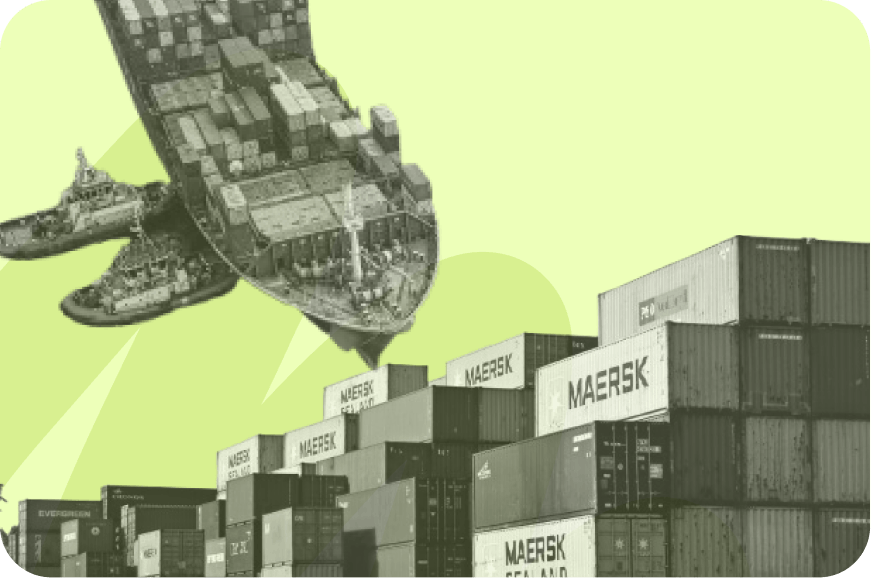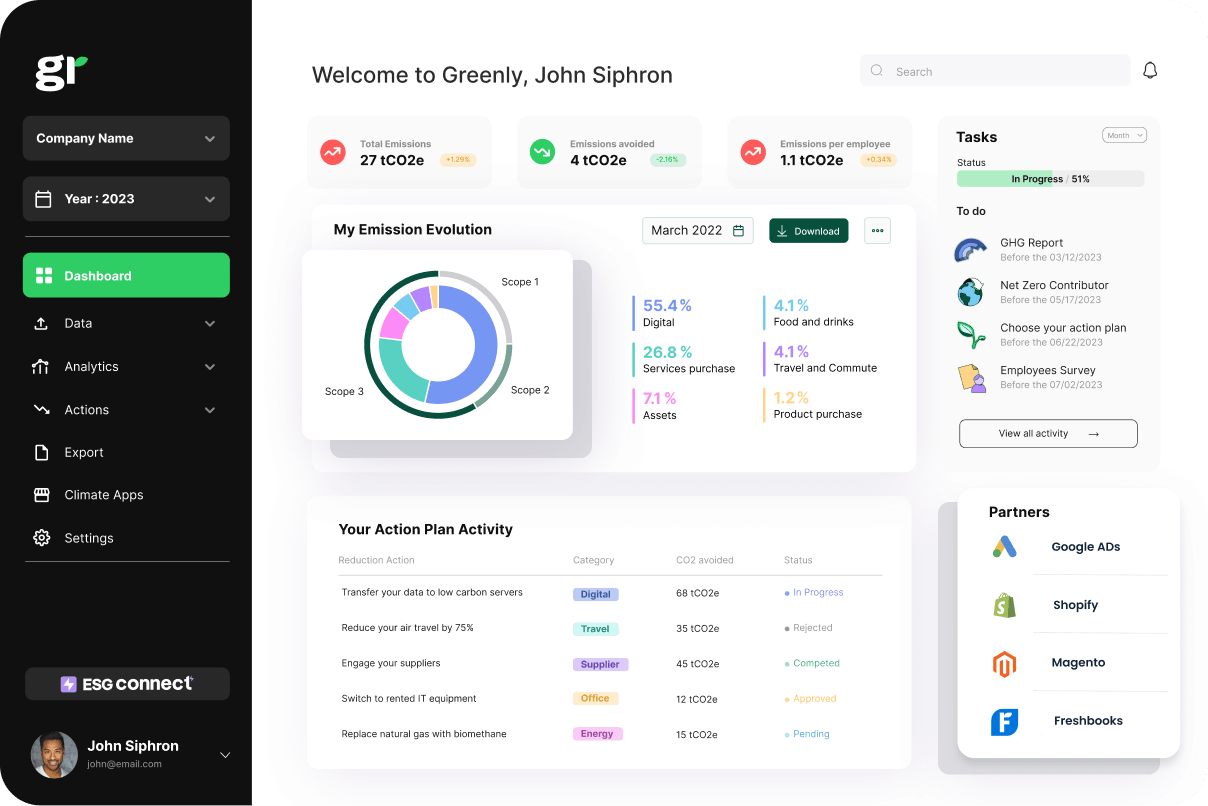
What are the 3 Pillars of Corporate Sustainability?
In this article, we'll explore what the 3 pillars of corporate responsibility are, why they're important, and how businesses can turn them into practical action.
ESG / CSR
Industries



When it comes to reducing your company’s carbon footprint, your supply chain holds the key. In fact, Scope 3 emissions - ie. those linked to your suppliers and value chain - can make up a staggering 90% of your total emissions. But here’s the challenge: how do you engage your suppliers in your journey toward sustainability and ensure they’re on the same low-carbon trajectory?
A well-designed supplier management policy is the answer. It not only helps companies tackle their environmental impact but also drives cost savings, strengthens brand reputation, and builds customer trust. Yet, many organisations struggle to take effective action in this area.
👉 In this article, we’ll walk you through the essentials of creating a supplier management policy, share real-world examples from industry leaders, and show how Greenly can help you engage your suppliers and decarbonise your supply chain.
When companies think about reducing their carbon footprint, attention often turns to internal operations or energy use. While these efforts are important, they only scratch the surface. The real environmental impact often lies in a company’s supply chain. Scope 3 emissions (those generated by suppliers and the broader value chain) typically account for the vast majority of a company’s overall footprint, sometimes as much as 90%.
Without addressing Scope 3 emissions, any sustainability strategy is incomplete. However, engaging suppliers in this process is often easier said than done. Many companies face barriers such as data gaps, lack of transparency, or supplier resistance. Yet, for those who act, the rewards are significant. Companies that implement effective supplier management policies report reduced costs, stronger supplier relationships, and enhanced resilience to environmental and regulatory risks.
👉 Beyond meeting sustainability goals, supplier management policies are increasingly essential for regulatory compliance. As governments and international bodies tighten rules on carbon disclosure, companies that fail to engage their suppliers risk non-compliance, reputational damage, and falling behind competitors.
Creating a supplier management policy that drives meaningful change starts with a clear framework. To effectively reduce emissions and align with sustainability goals, your policy must outline specific expectations, establish systems for evaluation, and foster collaboration with suppliers.
Your suppliers need to know what’s expected of them. This begins with setting clear sustainability criteria, such as:
Regularly evaluating supplier performance is essential for ensuring they meet your sustainability expectations. Assessments should go beyond basic compliance checks and include detailed reviews of suppliers’ carbon footprints, emissions data, and sustainability initiatives.
Audits provide a snapshot of where suppliers stand and help companies:
By conducting regular assessments, companies can not only track progress but also identify gaps and opportunities for collaboration, making their supply chain more resilient and sustainable.
A supplier management policy is only as strong as its ability to engage suppliers. Collaboration and transparency are critical for overcoming barriers such as limited resources, data gaps, or resistance to change. Actively involving suppliers in sustainability efforts turns your supply chain into a strategic partner in reducing emissions.
Key strategies for fostering engagement include:
Recognising and incentivising supplier progress can also strengthen engagement. Offering preferential contracts, public recognition, or other rewards motivates suppliers to prioritise sustainability.
Suppliers often face challenges in adapting to sustainability requirements, whether due to resource constraints or knowledge gaps. By co-developing transition plans, companies can help suppliers navigate the journey toward lower emissions and improved practices.
This process involves:
Acknowledging suppliers that meet or exceed sustainability benchmarks can encourage broader adoption of sustainable practices. Public recognition, inclusion in preferred supplier programs, or long-term contracts are powerful incentives that show suppliers the value of prioritising environmental goals.
For example, many companies develop "green supplier" programs, offering visibility or incentives to suppliers who achieve specific sustainability certifications or emissions targets. These programs not only drive individual supplier performance but also inspire other suppliers to follow suit.
To transform your supply chain into a green and profitable future, download our guide.

A robust supplier management policy does more than reduce emissions - it drives value across your organisation. From risk mitigation to customer loyalty, the benefits extend far beyond sustainability alone.
| Benefit | Description | Example |
|---|---|---|
| Risk Reduction | Mitigate reputational damage, legal liabilities, and supply chain disruptions by ensuring suppliers meet ethical and environmental standards. | Companies with sustainable procurement policies reported fewer disruptions during the COVID-19 crisis. |
| Cost Savings | Reduce procurement costs by 9–16% through resource-efficient suppliers and waste reduction. | Sustainable procurement practices can lead to significant cost reductions. |
| Revenue Growth & Loyalty | Appeal to sustainability-focused consumers willing to pay a premium for ethically sourced products. | Brands like Costco and Pandora use responsible sourcing to build trust and enhance customer loyalty. |
| Competitive Differentiation | Stand out in the market by demonstrating leadership in sustainability and transparency. | Aligning with regulatory and stakeholder expectations positions companies as industry leaders. |
Many companies are already leading the way in supplier management, demonstrating how engaging suppliers in sustainability efforts can drive tangible results. These examples illustrate the variety of approaches organisations are taking to reduce their Scope 3 emissions and align their supply chains with broader environmental goals.
AstraZeneca has integrated supplier engagement into its sustainability strategy by committing to science-based targets (SBTs). The company aims for 95% of its suppliers by spend, covering purchased goods and services and capital goods, and 50% of its suppliers by spend, covering upstream transportation and distribution and business travel, to set SBTs by 2025. This initiative is part of AstraZeneca's broader goal to reduce absolute Scope 3 greenhouse gas (GHG) emissions by 50% by 2030 (from a 2019 base year).
Pandora, one of the world's largest jewellery brands, has embedded sustainability into its procurement processes by prioritising the use of recycled materials. The company achieved its goal of using 100% recycled silver and gold ahead of schedule, thanks to a strong commitment from its suppliers. All suppliers have transitioned to sourcing materials certified as recycled according to the Responsible Jewellery Council Chain of Custody, one of the industry's strictest standards.
Airbnb recognises that its suppliers represent the largest portion of its emissions and has taken proactive steps to address this challenge through the Airbnb Supplier Sustainability Program. By the end of 2023, Airbnb had engaged nearly 70 suppliers, accounting for approximately 61% of its 2022 corporate emissions, in the first phase of this program.
The company collaborates with its suppliers to reduce its environmental footprint by focusing on energy efficiency, waste reduction, and sustainable sourcing. By providing resources and guidance, Airbnb ensures that its supply chain aligns with its corporate values of environmental responsibility, creating a ripple effect of positive change throughout its operations.
Costco actively engages its suppliers to ensure alignment with its sustainability goals, recognising that supplier actions play a critical role in achieving emissions reductions. To support responsible sourcing, Costco asks its suppliers six key questions addressing the impact of their practices on people, animals, and the environment. The company also requests detailed information about suppliers’ emissions plans, emphasising the importance of collaborative efforts to achieve mutual sustainability goals.
As part of its Planet Care strategy, Sanofi actively engages suppliers to reduce Scope 3 emissions and adopt sustainable practices. The company identified top CO2-emitting and strategic suppliers - accounting for 70% of supplier-related emissions - and onboarded them into its Supplier Engagement Program to collaborate on decarbonisation.
Sanofi also prioritises eco-design, working with packaging suppliers to:
By fostering collaboration, Sanofi ensures its suppliers play a critical role in achieving its environmental ambitions.
GSK: Driving Sustainability Across the Supply Chain
GSK’s Sustainable Procurement Programme tackles the 40% of its carbon footprint that originates from its supply chain. The company requires suppliers to disclose emissions, adopt renewable energy, and align with 1.5 degree Science Based Targets. Additionally, GSK emphasises sustainable sourcing, water neutrality in stressed areas, and waste reduction initiatives.
Engaging suppliers in sustainability efforts is critical for reducing Scope 3 emissions, but it’s not without its challenges. Companies often encounter barriers ranging from data gaps to resistance to change. Addressing these issues requires a combination of clear communication, supportive tools, and collaborative strategies.
Key challenges in supplier engagement:
| Challenge | Description |
|---|---|
| Lack of Transparency | Suppliers may hesitate to share data about emissions or practices due to competitive concerns or limited reporting systems. |
| Resource Constraints | Smaller suppliers may lack the financial or technical resources to implement sustainability initiatives. |
| Complex Supply Chains | Large organisations often work with a vast network of suppliers, making engagement and oversight more challenging. |
| Resistance to Change | Suppliers may be reluctant to adapt due to perceived costs, disruptions, or lack of understanding about sustainability benefits. |
| Data Quality and Accuracy | Inconsistent or incomplete emissions data from suppliers can undermine efforts to measure and reduce Scope 3 emissions. |
| Regulatory Misalignment | Suppliers operating in regions with varying sustainability regulations may face challenges in meeting global standards. |
To overcome these barriers, companies must prioritise collaboration, offer clear guidance, and provide tools to support suppliers in their sustainability journeys. By addressing these challenges head-on, organisations can build stronger, more resilient supply chains that align with their environmental goals. This is where specialised solutions like Greenly’s services can play a transformative role, empowering businesses to engage suppliers effectively and tackle these challenges with confidence.

Engaging suppliers in a meaningful way is often one of the most challenging aspects of addressing Scope 3 emissions. Many companies struggle with identifying the most impactful suppliers, collecting accurate emissions data, and driving meaningful change across their supply chain. This is where Greenly’s Supplier Engagement solution provides a game-changing advantage.
Greenly offers an all-in-one platform to help businesses decarbonise their supply chains while empowering suppliers to embark on their own sustainability journeys. By combining advanced analytics, supplier scoring, and collaborative tools, Greenly ensures that businesses not only measure and monitor supplier emissions but also take actionable steps to decarbonise their supply chain.
With Greenly, companies can:
Key Features of Greenly's Supplier Engagement Service:
Greenly’s structured process simplifies supplier engagement and sustainability initiatives:
As global challenges like climate change, resource scarcity, and social inequality continue to intensify, sustainable procurement is poised to play an even more critical role in shaping the future of business. Companies that integrate sustainability into their procurement strategies today are not only addressing current demands but also positioning themselves for long-term success in an increasingly regulated and sustainability-focused world.
The shift toward sustainable procurement is no longer optional - it’s becoming a competitive necessity. Companies that invest in sustainable supply chains are reaping benefits such as increased consumer loyalty, reduced operational risks, and access to sustainable finance. For example:
The future of sustainable procurement lies in deeper collaboration between companies, suppliers, and stakeholders. By working together, organisations can drive innovation in low-carbon solutions, design products with circularity in mind, and reduce their collective environmental and social impact.
At the same time, advancements in digital technologies will make sustainability more accessible. Platforms that provide real-time supplier insights, emissions tracking, and lifecycle assessments will become indispensable tools for procurement teams.
As companies continue to push boundaries, the integration of sustainability into procurement processes will move from being a competitive advantage to a fundamental expectation. Businesses that act now will not only meet today’s demands but also set the standard for tomorrow.
Greenly is not only equipped to support your business with sustainable procurement but also offers a suite of carbon management services to help you achieve your sustainability goals. Whether you’re looking to measure your carbon footprint, identify key emissions hotspots, or implement actionable reduction strategies, Greenly provides the tools and expertise to guide your organisation every step of the way.
Greenly’s user-friendly platform integrates with your existing systems, making carbon management both efficient and impactful. By partnering with us, you’ll not only reduce your emissions but also build resilience, enhance your brand reputation, and meet stakeholder expectations in an increasingly sustainability-focused world.
Get in touch with us today to see how Greenly can support your sustainability journey.
